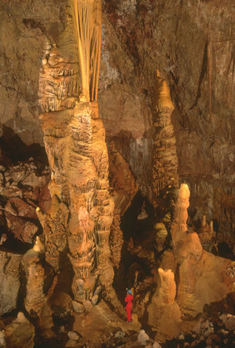A Tale of Two Cavemen
Two spelunkers who discovered extraordinary caverns are the subject of Neil Miller's new book
By Taylor McNeil
One day in November 1974, two young spelunkers squeezed into a sinkhole in a godforsaken area near the Whetstone Mountains, south of Tucson, Ariz. Judging by the graffiti on the wall, they weren't the first to make this passage. Soon they felt a brush of warm air and followed it through a small crack in the wall down a dark, narrow passage to another opening, a grapefruit-sized hole.
Click on the play button to begin the slide show.

To view the accompanying slideshow go to http://tuftsjournal.tufts.edu/2008/09/features/07/
After two hours, they had chiseled it wide enough to barely squeeze through. They wandered through more passages until they came upon a dreamlike setting: an undiscovered cave dripping with stalactites and stalagmites, a magnificent sight no human had ever seen.
The cave and its series of underground chambers that Randy Tufts and Gary Tenen discovered that day is now known as the Kartchner Caverns, the most popular state park in Arizona. The cavers kept their find a secret for 14 years to ensure the caverns would remain as pristine as when they discovered them.
Neil Miller, a lecturer in English and journalism at Tufts, heard about the caverns while he was in Arizona a few years ago. Intrigued, he went for a visit. Curious about the story of the cave's discovery, he went to the state park gift shop looking for a book describing it. There was none, and Miller, the author of four other books, realized this was a good story waiting to be told.
Soon Miller was interviewing Tenen and many others who had played roles in the saga of the Kartchner Caverns, named after the family on whose property they were found. The result, Kartchner Caverns (University of Arizona Press), is much more than a tale of lucky discovery, though. "There were a number of things about the story that appealed to me," he says. "It had an adventure story, an environmental story, and a bit of a spiritual dimension to it."
"Cavers are obsessed, driven people," says Miller. Tufts, for instance, had been fascinated by caves since he was a child. "His mother told me how he used to build fallout shelters in his backyard, and that his dream was to discover a virgin cave." Tenen had come from Chicago, and took up caving with Tufts, who was his college housemate at the University of Arizona. Tenen would even practice wedging his body through coat hangers to work on techniques for getting through what are known as blowholes, the small openings that lead to caves.
"Maybe there's an exploring impulse in all these people," says Miller. "I think it's in me-that's one of the things that drew me to the story."
Once Tufts and Tenen discovered the cave, they knew they had to protect it. Many other caves in Arizona were beset by thieves and vandals, and they resolved that would not happen to theirs. Miller documents all the precautions they took-even blindfolding state park officials when they took them to the site for the first time. "They felt this incredible responsibility," Miller says, "like the cave god had somehow given them the key to it and was relying on them to protect it and save it."
Finally, they brokered a deal that created the caverns as a state park, with the landowner selling the property to the state. In its first three years of operation, some 750,000 people visited the caverns, making it the prize of the Arizona State Parks system. It also accomplished what Tufts and Tenen set out to do: preserve a natural wonder.
Nowadays, visitors can stroll easily through the caverns, seeing such wonders as the 21.2-foot soda straw stalactite, which grows from the cave ceiling about one-tenth of an inch every century.
Miller got a personal tour with Tenen. "Gary took me through the cave the way he and Randy had discovered it, not the way the tours go now," Miller says. "That grapefruit-sized hole is bigger, but I had to crawl on my belly, and I walked through all this incredible mud they walked through." Regardless of the entrance you take, the site is "incredibly beautiful," he says.
Though the Kartchner Caverns are now well known, there are still other caves yet to be discovered. "There are some caves that spelunkers have kept really under wraps," Miller says. "It seems there are more worlds to conquer, if you're so inclined."
Neil Miller will be reading from and talking about his book, Kartchner Caverns, at Porter Square Books on Thursday, Sept. 18, at 7 p.m. The bookstore is located in the Porter Square Shopping Center, 25 White St., in Cambridge.
Taylor McNeil may be reached at taylor.mcneil@tufts.edu.


